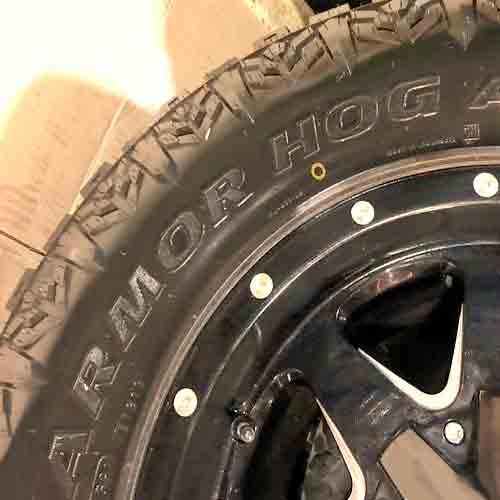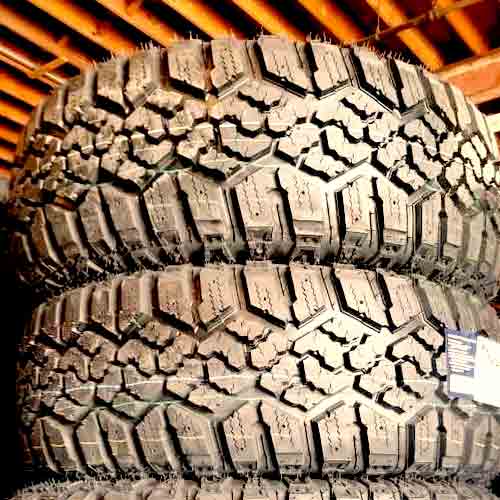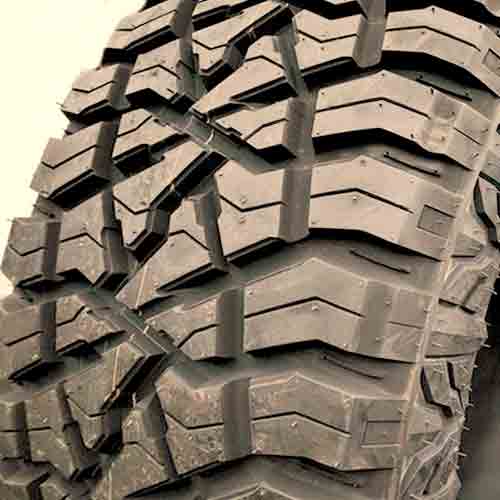Both the Kanati Trail Hog AT and the Armor Hog ATX are highly tuned versions of light truck all-terrain tires where their versatile tread designs allow you to conquer multiple terrains. Though still, let’s find a better tire for you here.

Available Sizes
Kanati Trail Hog A/T comes in 16 to 20 inches with following specs.
- Speed ratings: Q only.
- Load ratings: E only.
- Weight range: 45 to 75 lbs.
- Tread depth: 18/32″.
- Ratings: M+S and 3PMSF.
- Warranty: No mileage warranty.
On the other hand, the Kanati Armor Hog comes in 17 to 20 inches with following.
- Speed ratings: Q only.
- Load ratings: E only.
- Weight range: 45 to 85 lbs.
- Tread depth: 18/32″.
- Ratings: None.
- Warranty: No mileage warranty.
Tread Design
The Kanati Trail Hog is a very unique looking tire, clearly featuring its two parts, shoulders prominently separated form its central lugs.

Let’s consider the middle area of the tread first.
So here, you get to see smaller lugs, with sharp edges, and sipes (which are not full depth, BTW).
The interconnected grooves these lugs make, join up with the wider outer channels of longitudinal rings.
So with the closeness of these central lugs, the directional grip is also not compromised by much.
But of course, same can’t be said about shoulder lugs, as they get to little unstable while cornering on pavements, even though they are joined up with each other (supporting).
But with such tread depth (18/32″) and lugs surrounded with huge gaps, with bold stone ejectors, it makes sense why this tire is better off on rugged terrains, instead of on-road use, especially when it comes to lateral traction.
Moving towards the other tire, you get a slightly more aggressive pattern here.

In the middle, the tread although forms a 2 rib design, it’s very hard to picture them as blocks are placed very haphazardly.
This random placement of lugs basically provide off-road bite.
And helping to that, are their sharp edges, chamfered sides, and full depth sipes (which let the lugs divide up further providing extra grip, with flexing).
Though these lugs, at the same time, also stay stable on highways, as they all have reinforced foundations underneath them all.
Moving towards shoulders. These lugs are staggered, and have thick rectilinear sipes (like seen on lugs in the middle).
And their lateral gaps contain bold stone ejectors.
Moreover, on the outer edges, you also see a very unusual sidewall lug pattern.
Winter Traction
Winter performance considers various terrains like ice, deep snow, and on-road snow. And taking all these into account, the Kanati Trail Hog showcases superior capabilities and therefore carries a 3 peak mountain snowflake rating, unlike its counterpart.
The tire has exceptional snow gripping abilities, which enhance friction through snow-to-snow contact. Additionally, the tire also features studdable lugs, further improving traction on compacted snow.
In contrast, while the Kanati Armor Hog performs fairly well on deeper snow terrains, its overall performance lags behind in comparison, I mean consider all types of snowy conditions.
Dry Performance
Dry performance of these tires hinges on two critical parameters: lateral and directional traction. Let’s start with later, first.
Directional Grip
Directional grip, as the name suggests, pertains to the tire’s traction while moving straight. And while doing so, most of the weight on the tire gets concentrated right in the middle.
So it makes sense why the Kanati Trail Hog A/T is leading the way here with it’s closed up central lugs, forming greater rubber to road contact, compared to its counterpart.
My testing show, that the tire on average brake 4 feet shorter compared to Armor Hog, which gets to have a more voided up structure with its Z shaped grooves (which impede optimal ground to tread contact).
Dry Handling
As the tire turns, the weight shifts towards its shoulder due to inertia, so how well they contact the road (they’re on) is very significant here.
Unfortunately, the Kanati Trail Hog falls short in this area, with its relatively more voided up structure, it does not offer as much of the road connection as its counterpart.
Moreover, the Kanati Armor Hog ensures excellent steering response.
Basically its lugs are supported by reinforced foundations that enhance their stability, maintaining their form during cornering.
And this of course, reduces bending (of the lugs), and promotes a better balance between understeering and oversteering.
Wet Traction
Achieving effective wet traction involves taking into account two key factors: wet grip and hydroplaning resistance. So let’s unpack these elements separately.
Hydroplaning
Also known as aquaplaning, hydroplaning occurs when a layer of water forms between the tire tread and the road, causing the tire to lose contact with the road surface.
This basically happens when the tread isn’t able to disperse off water (mostly through grooves), in time.
But since both tires offer pretty aggressive tread voids, this concern is substantially minimized.
These voids allow water to be quickly and efficiently evacuated, enhancing float speeds in both straight and curved aqua.
(Float speed is the maximum speed a tire can achieve over water without floating).
Now keep in mind, although this is a common strength in both of these off-road tires, it doesn’t necessarily translate into similar wet gripping values.
Wet Grip
A tire’s ability to grip on wet roads is primarily determined by its siping. And in this aspect, the Kanati Trail Hog, with its dual siping design, offers more effective traction.
Moreover, these sipes are also full depth, so it’s wet traction is kept almost similar even with wear.
On the other side, the Armor Hog utilizes a rectilinear siping structure, which also doesn’t go deep all the way.
So you get very limited water wiping abilities here (since sipes literally suck water particles in), which gets poorer with wear.
Tread Wear
A tire’s tread wear can be impacted by numerous elements, such as rolling resistance, the material used in the tire, and the depth of the tread.
Therefore, tires made from softer materials or those with shallow tread to wear out faster.
Having said that, it was amazing to see both tires showing up with very similar results.
I mean, the Trial Hog is although lighter, it’s softer compound still produces a good deal of lug bending, which causes heat, and as a result lowers tread life.
Whereas even with heavier weight, which puts more pressure on tread/lugs, the Armor Hog offers similar tread life thanks to it’s reinforced foundational supports underneath each of its tread block.
However, it should be noted that both tires do not come with any mileage warranty.
Fuel Usage
Although the Kanati Trail Hog A/T is a lighter tire, its wider tread voids result in its lugs bearing more pressure, leading to higher rolling resistance.
And here the culprit is the tire’s softer composition, which results in greater deformation of the tread, leading to energy wastage due to increased lug bending.
Conversely, the Kanati Armor Hog establishing a stronger bond with the road, reduces the susceptibility of its lugs to bend as much as seen on its counterpart.
In other words, this tire is more efficient as it uses less energy in deforming its tread, and instead, channels that energy into the tire’s rotation.
Durability
Off-road terrains exert strenuous pressure on tires, so needless to say, they must be durable enough to survive.
That’s why both of our Kanati boys here offer 3-ply polyester casings, which are layered with two steel belts, reinforced with two more layers of nylon.
Though still our testing show that the Kanati Armor Hog is able to take on slight more abuse. This is attributed to more robust sidewall lugs (sidewalls are a common site for most of the punctures).
Mud Traction
Navigating through mud necessitates two key features: lugs capable of scooping and a self-cleaning tread. And with these considerations, the Kanati Trail Hog A/T fits the bill perfectly.
This tire features broader longitudinal grooves encircling its bulky shoulder lugs, and these offer a more rapid expulsion of thick clay, while the (numerous) biters in the middle effortlessly cut through, or you can say, breakdown the mud particles (so they can pass out easily).
In comparison, while the Kanati Armor Hog also features fairly decent interconnected tread voids, they are not as wide or effective at expelling mud swiftly.
Nevertheless, its sidewall lugs are highly effective in shoveling its way out, even when submerged deep in mud.
Overall, leave with this here: you can never go wrong going with any of these tires here.
Rocky Traction
Crossing rocky terrain requires treads with gripping edges in both horizontal and vertical directions, along with sturdy sidewalls, inside and out.
And here, although both tires are pretty impressive, the Kanati Armor Hog still takes the lead.
The tire’s triangular lugs and Z-shaped grooves provide grip from various angles, and the lugs on the sidewalls flex under decreased air pressure, yielding additional footprint and lateral traction – both crucial for rocky terrains.
The Kanati Trail Hog on the other hand, although has the edge of it’s more malleable lugs sticking on all types of rocky surfaces like a champ, it’s lateral traction can still be improved.
Sand Performance
For effective navigation on sand, it’s important to reduce the tire’s air pressure, as this enables the tire to “float” on this soft surface.
So here, having softer tread compound and lighter structural weight helps a lot.
And that’s the reason why you see superior results on Trail Hog A/T, as the tire’s pliable lugs offer superior footprint with the sand, with lowered air pressure.
This basically lowers down the overall density of the tire, and it’s not that susceptible to getting stuck, whereas the Armor Hog with sharper edges, and harder compound, sinks more easily into the soft sand, comparatively.
Summary
The Kanati Armor Hog excels in the following areas:
- Durability: Thanks to its robust sidewall lugs, the Kanati Armor Hog has shown to be more resistant to abuse, particularly punctures.
- Dry Handling: The Kanati Armor Hog ensures excellent steering response. Its lugs are supported by reinforced foundations that enhance their stability, maintaining their form during cornering.
- Fuel Usage: Despite being a heavier tire, the Kanati Armor Hog is more energy-efficient, reducing its rolling resistance and channeling energy more effectively into the tire’s rotation.
- Rocky Traction: With triangular lugs and Z-shaped grooves, the Kanati Armor Hog provides grip from various angles, with its sidewall lugs flexing under decreased air pressure for additional lateral traction on rocky terrains.
The Kanati Trail Hog A/T performs better in the following aspects:
- Directional Grip: With its closed central lugs, the Kanati Trail Hog A/T has superior traction while moving straight, offering a better rubber-to-road contact.
- Wet Grip: The Kanati Trail Hog A/T’s dual, full-depth siping design provides more effective traction on wet roads.
- Mud Traction: The Kanati Trail Hog A/T’s design features broader longitudinal grooves and numerous middle biters, making it more efficient at expelling mud and cutting through it.
- Sand Performance: With a softer tread compound and lighter structural weight, the Kanati Trail Hog A/T performs better on sand surfaces, with its pliable lugs offering superior contact.
- Winter Traction: The Kanati Trail Hog A/T showcases superior capabilities in various winter terrains and carries a 3 peak mountain snowflake rating.
In the case of Tread Wear, both tires showed similar results, neither clearly outperforming the other. And for Hydroplaning, both tires also performed similarly well due to their aggressive tread voids, which help to quickly and efficiently evacuate water.